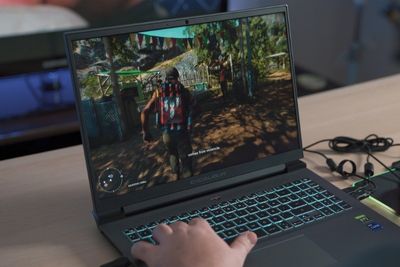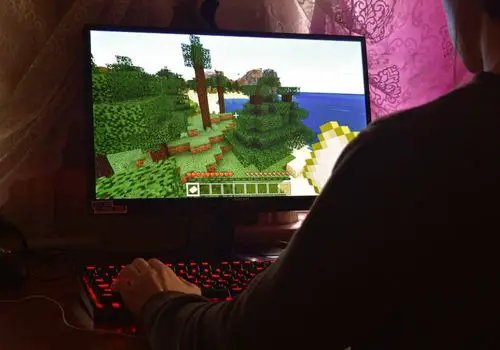
In its most basic form, Minecraft doesn't take up a lot of disk space. Regardless of the platform, the base installation will always be less than 2 GB, and on most devices, it is closer to 1 GB. However, as you add more content like resource packs and new Minecraft worlds, the size of the game will increase. In some cases, it can be as large as a few tens of gigabytes.
I recently had to use a backup laptop for a couple of weeks and I wanted to install Minecraft. I had to find out how much space the game takes up because I didn't have too much free space on that system. This led me to find answers to how much storage Minecraft takes up, and I've put them in this guide for you.
If you want to know how much storage Minecraft takes up, you've come to the right place. Let's get right into what you need to know.
Contents
Just by comparing it to other modern games, it's easy to tell that Minecraft doesn't need too much storage space on your computer.
If you want to play Minecraft, the first thing you need to do is download the installation files. Regardless of the edition of the game, the installation files are small. The setup file is about 500 MB for Java Edition and 900 MB for Bedrock Edition.
Of course, once you install the game, the amount of space it takes up increases. However, it's just a little over 1 GB.

The minimum requirements for Minecraft are set at 1 GB of disk space. However, to have it run smoothly, you should try to have at least 2 GB free.
Note that 1 GB is the size of the base installation for Minecraft - that is, only the essential Minecraft files needed for the game to run.
Once you start playing and making your own Minecraft worlds or adding texture packs and other mods to the game, the space it takes up will certainly increase. It can end up being several gigabytes large.
So, how much storage does Minecraft take up on your computer? The most accurate way to see its impact on storage space is to go to the installation folder and take a look at its properties.
However, the Minecraft storage is not in the Program Files folder as you might expect, but in a hidden folder elsewhere. Don't worry though, I'll show you how to find it.
Before you do so, you'll need to get Windows to show hidden files and folders. The steps to follow depend on the OS version you have installed.
On Windows 10:
For Windows 11:
Now that hidden files and folders are showing, here's how to get to the Minecraft file location on a Windows PC:
Alternatively, you can find your way to the Minecraft directory from inside the game. This will work on any platform.

You can now see how much of your system storage Minecraft uses up on your PC. How much space does Minecraft take on your Mac computer, and how can you find out?
Well, fortunately, there's a feature you can use in the game to find out. Just follow the steps below:
Not everyone plays Minecraft on their Windows PC. Even if you play Minecraft on any other platform, you might want to know how much space Minecraft takes up.
Well, the good thing is that it doesn't matter which platform you're on. Minecraft is a small game. All base installations are less than 2 GB and increase as you add texture packs, new worlds, mods, and so on.
For instance, on macOS, how much space does Minecraft take up? Well, on a Mac device, the game is surprisingly small. After being installed, it'll take up just about 385 MB on your computer, which leaves you with a lot of space for other things.
Minecraft is the biggest by default on Wii U, and it is just over 1.6 GB, followed by Xbox One where it is approximately 1.3 GB.
When it comes to how much space the Nintendo Switch version of the game uses, it falls just under Microsoft's console at 1.1 GB.
On all other popular platforms that this game can be played, Minecraft storage space is quite small.
Below are the file sizes for the base installations for different platforms:
We've mentioned the base installation size of Minecraft. It's likely to be several times larger than its base size, depending on how much content you have.
The main thing that will increase the size of your storage files is the extent of your Minecraft world.
When you create a Minecraft world, it's not saved to the disk from the start. It's only once you start to explore the world that the game builds the places you venture into and stores world data on your hard drive.
This means that the more you explore, the more space it takes up on your computer.
However, other factors can increase the space that the game takes up. I'll get into the main points below.

Resource packs serve as a way to change the aesthetic aspects of your game, without adding any functionality that wasn't already part of the game's built-in feature set.
To better explain this, installing a resource pack can give you access to new textures for the blocks in the game, new skins, as well as additional sounds, fonts, animations, and more.
If your resource pack changes a lot of textures, sounds and other elements, it's bound to have a larger file size. This will result in Minecraft taking up more space.
PC gaming has always been big on mods, and the same applies to Minecraft.
Mods are essentially add-ons that can give your game some new functionality; whether it is with new weapons, environments, items or monsters.
Depending on the kind of installed mods you have, your Minecraft installation can increase by a few hundred megabytes to several gigabytes. For instance, the popular raytracing mod for Minecraft adds close to 40 GB to the game's total file size.
As we mentioned, the more you build or explore a simple Minecraft world, the larger its size becomes.
However, since you can have multiple saved worlds in your game, these will further increase the storage size. This is especially true when you have Minecraft worlds that are well-traveled and explored.
Basically, the more Minecraft save files you have on a single computer, the higher the file size.
Plugins in Minecraft are used to give additional features to the game. However, unlike mods, they do not directly affect the mechanics of the core game.
Plugins are typically used in active multiplayer worlds, and they have a lot of cool features. For instance, a plugin can be used to add an economy, help organize factions of players, and make it possible to set up user rankings.
Similar to the other points, the more plugins you have installed in your multiplayer world, the larger the file size will be.
Hosting a Minecraft server can potentially increase your Minecraft storage requirements the most, compared to some of the other things we've talked about.
Your server hosts other players, and with all the building and exploring they do, it adds to the file size of the world on your server. In addition, when a Minecraft client creates a world on the server, it has to be stored on your system. This further increases the final game size.
Before you jump into hosting a server, make sure that you have several tens of gigabytes free, especially if you want it to be a huge world with hundreds of players.

If you know the size of your Minecraft world, getting rid of it can help to free up a substantial amount of space from your system storage.
Of course, you don't want to delete worlds that you spent years building. So, you might wonder if there's a way to transfer worlds to a safe location on your PC until you're ready to play again.
You can backup your Minecraft file in a few easy steps. This works on PC, Nintendo Switch, as well as PlayStation and Xbox consoles:
How much space does Minecraft take on your computer and other devices? Minecraft is a small game, so in most cases, the base game is less than 2 GB. In some cases, it is just a few hundred megabytes, especially if you play on mobile devices.
However, the file size for Minecraft will increase depending on how many worlds you have, the number of files in your mods folder, whether you host a multiplayer server and have plugins, and so on.
We hope this article helped you learn everything about the file size of Minecraft and the amount of space it takes up. If so, take a look at our related articles to learn more.
